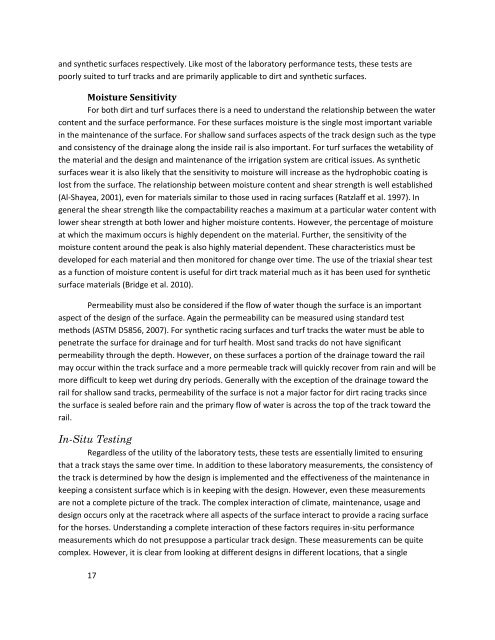Retired Racehorses
tfrr_reportandappendicesfinal
tfrr_reportandappendicesfinal
- No tags were found...
Create successful ePaper yourself
Turn your PDF publications into a flip-book with our unique Google optimized e-Paper software.
and synthetic surfaces respectively. Like most of the laboratory performance tests, these tests are<br />
poorly suited to turf tracks and are primarily applicable to dirt and synthetic surfaces.<br />
Moisture Sensitivity<br />
For both dirt and turf surfaces there is a need to understand the relationship between the water<br />
content and the surface performance. For these surfaces moisture is the single most important variable<br />
in the maintenance of the surface. For shallow sand surfaces aspects of the track design such as the type<br />
and consistency of the drainage along the inside rail is also important. For turf surfaces the wetability of<br />
the material and the design and maintenance of the irrigation system are critical issues. As synthetic<br />
surfaces wear it is also likely that the sensitivity to moisture will increase as the hydrophobic coating is<br />
lost from the surface. The relationship between moisture content and shear strength is well established<br />
(Al‐Shayea, 2001), even for materials similar to those used in racing surfaces (Ratzlaff et al. 1997). In<br />
general the shear strength like the compactability reaches a maximum at a particular water content with<br />
lower shear strength at both lower and higher moisture contents. However, the percentage of moisture<br />
at which the maximum occurs is highly dependent on the material. Further, the sensitivity of the<br />
moisture content around the peak is also highly material dependent. These characteristics must be<br />
developed for each material and then monitored for change over time. The use of the triaxial shear test<br />
as a function of moisture content is useful for dirt track material much as it has been used for synthetic<br />
surface materials (Bridge et al. 2010).<br />
Permeability must also be considered if the flow of water though the surface is an important<br />
aspect of the design of the surface. Again the permeability can be measured using standard test<br />
methods (ASTM D5856, 2007). For synthetic racing surfaces and turf tracks the water must be able to<br />
penetrate the surface for drainage and for turf health. Most sand tracks do not have significant<br />
permeability through the depth. However, on these surfaces a portion of the drainage toward the rail<br />
may occur within the track surface and a more permeable track will quickly recover from rain and will be<br />
more difficult to keep wet during dry periods. Generally with the exception of the drainage toward the<br />
rail for shallow sand tracks, permeability of the surface is not a major factor for dirt racing tracks since<br />
the surface is sealed before rain and the primary flow of water is across the top of the track toward the<br />
rail.<br />
In-Situ Testing<br />
Regardless of the utility of the laboratory tests, these tests are essentially limited to ensuring<br />
that a track stays the same over time. In addition to these laboratory measurements, the consistency of<br />
the track is determined by how the design is implemented and the effectiveness of the maintenance in<br />
keeping a consistent surface which is in keeping with the design. However, even these measurements<br />
are not a complete picture of the track. The complex interaction of climate, maintenance, usage and<br />
design occurs only at the racetrack where all aspects of the surface interact to provide a racing surface<br />
for the horses. Understanding a complete interaction of these factors requires in‐situ performance<br />
measurements which do not presuppose a particular track design. These measurements can be quite<br />
complex. However, it is clear from looking at different designs in different locations, that a single<br />
17


